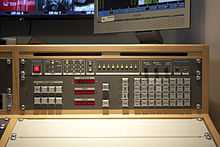Video router
A Video router or Matrix are used for transporting video signals from sources or inputs to output destinations.

Inputs and outputs
The number of inputs and outputs varies dramatically. Routers are normally described by number of inputs by number of outputs e.g. 2x1, 256x256, 576x1152. Some video routers, by the use of additional drop-in cards, allow the system to be expanded for more inputs or outputs, or to support other formats. [1] [2]
Signals
The signal format that the router transports can be anything from analogue composite video using PAL and NTSC. Also multi-format routers can route more than one Digital video signal format, Serial Digital Interface (SDI), HD-SDI, component video. Some routers have the ability to internally convert digital to analog and analog to digital. For HD Video, HDMI Matrix switch can be used to switch any HDMI source to any connected HDTV using a HDMI connection.
More recent developments have allowed audio embedding and de-embedding within the router, this allows for audio to be routed along with video.
Crosspoints
Because any of the source can be routed to any destination, the internal arrangement of the router is arranged as a number of crosspoints which can be activated to pass the corresponding source signal to the desired destination. This architecture has guaranteed bandwidth and is non-blocking.
Crosspoints can also be switched in the vertical interval to avoid losing picture information, for this the router would need to be genlocked to either black and burst or tri level sync
Control

Many type of broadcast automation systems can be used to control a video router via IP, or serial communications such as the RS-422 9-Pin Protocol.
Manufacturers
- Ross Video
- Blackmagic Design
- Datavideo Corporation
- Ampex
- Evertz Microsystems
- Imagine Communications
- Miranda Technologies (NVision)
- Nevion
- Octava
- PESA Switching Systems
- Snell (Pro-Bel)
- Thomson Grass Valley
- Sony
- Utah Scientific
- Matrix Switch Corporation
- RGBLink